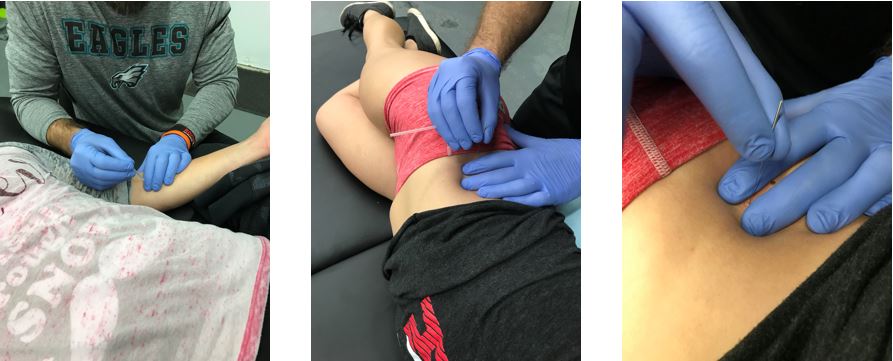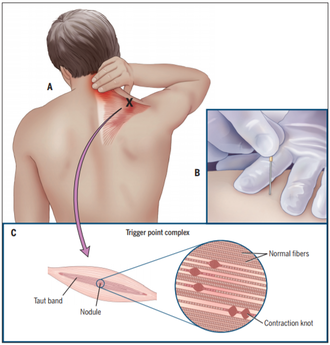Often when I bring up the technique of Dry Needling with my clients, they either cringe or start to nervously ask what I’m talking about. Being that it’s a powerful technique at The Charlotte Athlete, I thought it was only fitting to write our first blog post on this topic. Hopefully after reading this article you will have a better understanding of what it is, how it works, and how it may benefit you.

What is it?
Dry needling is a unique physical therapy treatment that involves the use of a thin, flexible needle to address underlying myofascial trigger points within muscular and connective tissues, for the management of musculoskeletal pain and movement impairments. It’s called “dry” needling because there is no solution injected (versus a hypodermic needle during a flu shot). With dry needling, the needle itself and the effects it produces within the tissue is the treatment.
The primary goals are to alleviate pain, stimulate tissue healing, restore muscle function, decrease muscle tension, desensitize supersensitive structures, and improve muscle contractility. In the hands of a skilled physical therapist, this powerful tool has the ability to create pronounced changes in athletes and greatly improve their ability to perform their activity or sport.
What is a trigger point?
A trigger point is what we target within muscles. It’s basically an irritable or taut band of dysfunctional muscle tissue that is usually the result of overuse, postural abnormalities, muscular imbalances, or nerve impingement. When an injury occurs from repetitive use or acute trauma, inflammation will be produced from the damaged tissues. The damaged tissues will often go into a protective tension state or contracture to guard against further damage from utilizing the injured tissue. This contracture and inflammation inhibits microcirculation which limits both the oxygen rich blood reaching the injury and the waste products leaving the injury. Increased waste products created by the hypoxic and acidic environment are caustic to the tissues. This limits the tissues ability to fully function (contract/ relax) which may inevitably lead to biomechanical disturbances throughout the body which can limit function and decrease range of motion and performance.

Is dry needling the same as acupuncture?
Absolutely not! Dry Needling is completely different from acupuncture. While we do use the same types of needles, our methodology and rationale is different than that of an acupuncturist. Traditional Chinese Medicine explains acupuncture as a technique for balancing the flow of energy, or Chi, through meridians, which are pathways within your body. By inserting needles into specific points along these meridians, acupuncturists believe that your energy flow will be re-balanced. Dry needling, however, is a technique used to treat the neuromusculoskeletal systems based on pain patterns, muscular dysfunction, and other orthopedic signs and symptoms which depends upon the clinical presentation. Most if not all of traditional acupuncture is based on pre-scientific ideas, whereas dry needling is based on modern scientific research and a deep and thorough understanding of anatomy. While I’m not trained in acupuncture, I am trained in the anatomy of the human body, which is what guides the choice for where to perform dry needling.
How dry needling can help you
So how does dry needling cause muscle pain to resolve so quickly? There are a couple of theories on how this happens but I want to explain it in terms most of us can understand. Think of a trigger point similar to a glitch on a computer. Something isn’t working right which causes other things to not work right. What fixes most computer glitches? The restart button! Dry needling is like the restart button to the musculoskeletal system. If we have an irritated trigger point and we put a needle in it, it resets.
Dry needling can also be thought of as the “sniper” of manual therapy. Like a gunman with the extreme precision and skill of a sniper, we can use a needle to pinpoint and eliminate the problem area. We can use dry needling to treat just about any orthopedic issue that presents in our clinic. From cervicogenic heads to lower back pain to plantar fasciitis, dry needling can help manage a large variety of impairments. Anyone suffering from tight muscles, muscle spasms, nerve impingement, tendinitis, or bursitis are excellent candidates for dry needling. By resetting the muscle with dry needling, the muscle is allowed to function as designed and the stress and inflammation on the bursa, tendon, or nerve is relieved.
While results can happen instantly in many cases, dry needling is NOT a be-all-end-all treatment technique, and typically is a part of a larger treatment plan. Identifying and treating the underlying cause, along with addressing areas like mobility, strengthening, and improving movement patterns are critical to sustain long term pain-relief. If you are experiencing pain or restrictions, regardless of your fitness level, I highly recommend seeking out a physical therapist in your area who performs dry needling. It is a great tool in the hands of a skilled physical therapist to alleviate pain that otherwise would prevent an athlete from performing certain movements or exercises. If you live in Charlotte and are struggling with pain, contact one of our Doctors of Physical Therapy. We offer free phone consultations and free 20-minute discovery visits to ensure you are a good candidate. Please do not hesitate to reach out with any questions!
Thanks for reading,
Dr. Andrew

